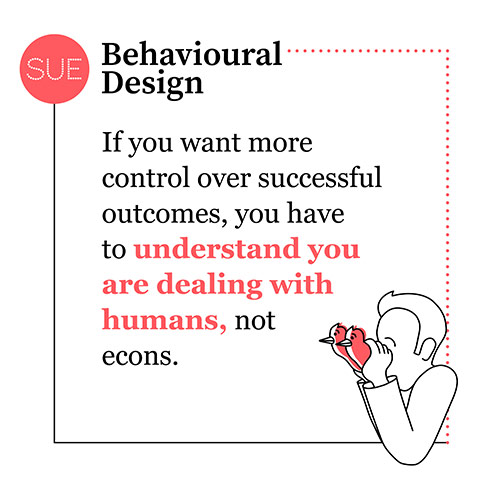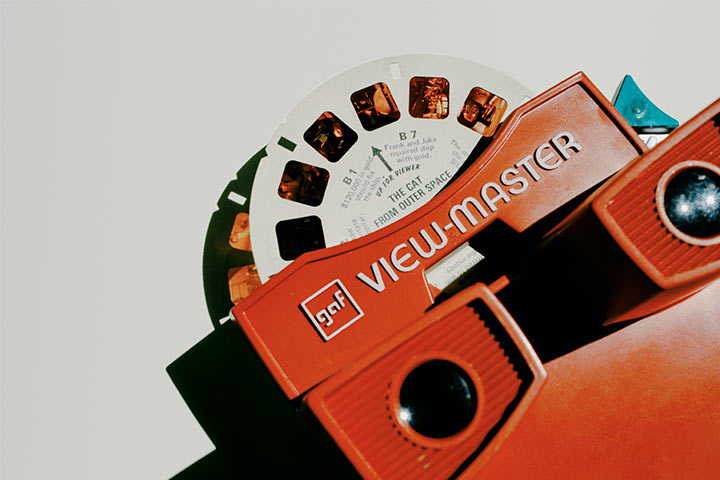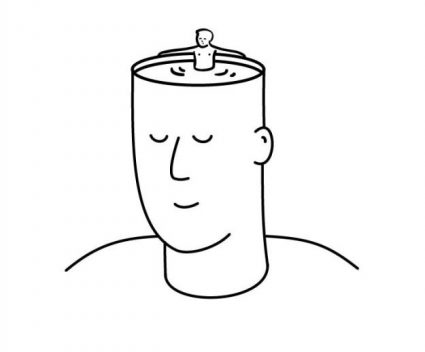Behavioural economics, maybe you have asked yourself once or twice, what’s all the fuss about? Why is everybody talking about us not being rational and capable of making good decisions all of a sudden? Is Behavioural Design something you should add to your competence gamma, and if yes, why so? This is a short introduction to behavioural economics. Meant to bring you up-to-speed with what everybody seems to be talking about right now in a simple way. In fact, I could summarise what’s in it for you in one sentence:
If you want more control over successful outcomes, you have to understand you are dealing with humans, not econs.
The difference between economics and behavioural economics
Okay, I admit this sounds vague without any background. Basically, it comes down to a difference in paradigm on decision-making between economists and psychologists that gave birth to a beautiful cross-over between the two: behavioural economics (also known as behavioural psychology). What is it all about?
Let’s start with a problem we have probably all faced. Many new products, ventures, policies or innovations of any kind fail because they don’t take a deep understanding of human decision-making into account. They are inside-out, not inside-in driven. Therefore, innovations are often technological high-end, make things more cost-effective or offer different unique selling points, but they don’t start at the end. How do people choose for your offering? What psychological effects does pricing have? What’s, is the impact of social influence? Does the way we display products or frame policies affect decision-making? Which unconscious psychological forces influence our decision-making? Do those forces make objective sense?
According to an economist, the answer is:
- Decision-making is rational.
- People make a cost-benefit analysis.
- The utility is a critical driver of any choice we make.
However, if you have ever had any regret after purchase or not making a purchase, you know that economist rule out one crucial factor: emotion. Emotions from within and emotions attached to what we think others think or expect from us. We are not 100% rational (or econs); we are filled with emotions and sometimes make decisions that are a far cry from most optimal for ourselves or our future.
Behavioural economics put emotions into the economic equation.

 Bounded rationality: critical concept of behavioural economics
Bounded rationality: critical concept of behavioural economics
Furthermore, economists propose people always have all information at hand to make informed decisions. But is that true? First of all, we are bombarded with information all day long via multiple channels and media. No sane person can process all this rationally. Secondly, do we truly have all information to make informed decisions, for example, about our future? This is where we really have to make crucial decisions, after all. Buying an ice cream is not so hard but deciding upon your mortgage or pension plan is a whole different ballgame. Do you have all the information at hand to make a 100% rational decision here?
For example, do you know exactly your income level in 5, 10 or 15 years? Do you know what the inflation ratio will be in the same periods? Do you know what your health level will be like? Will you be able to work full-time, part-time or be out of work?
Rationality requires completeness of information, computational abilities, consistency in decision-making and cognitive skills (ability to think through a problem unemotionally). No human scores 100% on all these factors. So, what do we do when faced with a decision? We rely on short-cuts and social cues in our context and past experiences. We are only human, after all.
Taking the human, so-called bounded-rational part of us into the decision equation is what behavioural economics is all about.
Behavioural economists have researched and unlocked these human tendencies for years. Behavioural Designers take this behavioural science to design environments that help shape positive behaviours and choices of people. In fact, by using the exact science and combining it with design and creativity, we can create tangible products, services, policies, or organisations that help people make better decisions for their health, wealth and happiness.
Behavioral Design is applied behavioural economics.
Want to shape behaviour and decisions?
Then our two-day Fundamentals Course is the perfect training for you. You will learn the latest insights from behavioural science and get easy-to-use tools and templates to apply these in practice right away!
 Behavioural economics: a game of choice architecture
Behavioural economics: a game of choice architecture
One final note: How can we design environments that shape positive behaviours and better choices? Often, we think we need disclosure. Make sure you provide people with all the required information to help them make their informed decision. Unfortunately, that again is an econ approach to matters. Even if you help people with the information they need for a particular decision, we as humans often don’t use it. Most of the times, we know what is good for us but don’t act upon it.
For example, we all know exercising is good for us, and I guess we have all made a plan to do some form of exercise one day or the other, but most of us either started and stopped or are still procrastinating. This is known as the planning-action gap or intention-action gap. This is not new, of course, as we see in general three tools being applied to get humans into action:
- Restrictions (you cannot buy alcohol under the age of 18)
- Incentives (if your child attends school five days a week, you will get more child support)
- Selling (convincing people by telling them about benefits or USPs)
Behavioural Designers use another tool: choice architecture. We take humans and a deep understanding of their decision-making processes as a starting point to design a context that triggers better choices and behaviours. We do it using our SUE | Behavioural Design Method©, a highly structured, practical approach to turn human insights into strategies and ideas that influence better choices and shape positive behaviours. Basically, turning the breakthrough science of human behaviour into practical applications. What this results in, you can check out on our success stories page.
 Summary: What’s behavioural economics all about
Summary: What’s behavioural economics all about
For now, I just want to wrap it up with the three things to remember when designing better choices and behaviours:
- You are dealing with humans, not econs
- Humans use cues in their context to make decisions
- You need to be aware of the intention-action gap
Taking these three principles as starting point already jumpstarts you in thinking as a behavioural designer. And understanding what all the fuss about behavioural economics is about (and how important it is to get a grip on success).
Cover visual by Red with the Red Hat on Unsplash.
BONUS: free ebook 'Behavioural Economics: the Basics'
Especially for you we've created a free eBook 'Behavioural Economics: the basics'. For you to keep at hand, so you can start using the insights from this blog post whenever you want—it is a little gift from us to you.
How do you do. Our name is SUE.
Do you want to learn more?
Suppose you want to learn more about how influence works. In that case, you might want to consider joining our Behavioural Design Academy, our officially accredited educational institution that already trained 2500+ people from 45+ countries in applied Behavioural Design. Or book an in-company training or one-day workshop for your team. In our top-notch training, we teach the Behavioural Design Method© and the Influence Framework©. Two powerful tools to make behavioural change happen in practice.
You can also hire SUE to help you to bring an innovative perspective on your product, service, policy or marketing. In a Behavioural Design Sprint, we help you shape choice and desired behaviours using a mix of behavioural psychology and creativity.
You can download the Behavioural Design Fundamentals Course brochure, contact us here or subscribe to our Behavioural Design Digest. This is our weekly newsletter in which we deconstruct how influence works in work, life and society.
Or maybe, you’re just curious about SUE | Behavioural Design. Here’s where you can read our backstory.










